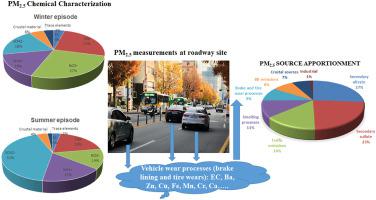Atmospheric Pollution Research ( IF 4.5 ) Pub Date : 2021-05-20 , DOI: 10.1016/j.apr.2021.101092 Geun Hye Yu , Seunghik Park

|
It is crucial to investigate the chemical species that cause increases in PM2.5 concentration and to quantitatively estimate source contributions to PM2.5 in urban environments in order to establish strategies to control anthropogenic air pollution. In this study, measurements of 24-hr integrated PM2.5 were performed for 1 year at an urban site in Gwangju, Korea. The collected samples were analyzed for organic and elemental carbon (OC and EC), water-soluble OC (WSOC), eight ionic species, and elemental species, which were used to estimate source contribution of PM2.5 using a positive matrix factorization (PMF) model.
The dominant species that contributed to PM2.5 during the study period was organic matter (OM), which accounted for 24% of PM2.5. The major chemical species resulting in PM2.5 pollution episodes (>24-hr Korean PM2.5 standard of 35 μg/m3) depended on the season. For example, PM2.5 increases in winter were strongly associated with increases in secondary nitrate and OM concentrations, while rapid increases in secondary sulfate concentration brought on summertime PM2.5 increases.
A total of eight sources of PM2.5 were identified using PMF analysis: secondary nitrate (26%), secondary sulfate (23%), traffic emissions (14%), metallurgical and smelting processes (11%), brake and tire wearing processes (9%), biomass burning emission (8%), crustal source (7%), and industrial sources (1%). The brake and tire wearing processes were a non-negligible contributor to total PM2.5 at the study site, accounting for 7% of PM2.5 in summer and 18% in fall. Metallurgical and smelting processes, which are highly enriched in elements such as Pb, Cu, As, Se, and Zn, were also found to be an important source of PM2.5 at the study site, contributing 7% of PM2.5 in summer and 14% in fall. Moreover, the total contribution of mobile-related emissions, such as vehicles and brake and tire wearing processes, to PM2.5 ranged from 15.2% in summer to 40.0% in winter with an average of 23%. Overall, the results of this study suggest that control of mobile-related sources is crucial to reducing the high PM2.5 levels in the Gwangju metropolitan area.
中文翻译:

韩国光州市区的PM 2.5的化学表征和源解析
为了建立控制人为空气污染的策略,研究导致PM 2.5浓度增加的化学物质并定量估算源对PM 2.5的贡献至关重要。在这项研究中,在韩国光州的一个城市地点对一年中的24小时集成PM 2.5进行了测量。分析收集的样品中的有机碳和元素碳(OC和EC),水溶性OC(WSOC),八个离子物种和元素物种,这些元素用于通过正矩阵分解(PMF)估算PM 2.5的源贡献。模型。
在研究期间,造成PM 2.5的主要物种是有机物(OM),占PM 2.5的24%。导致PM 2.5污染发作的主要化学物质(大于24小时的韩国PM 2.5标准浓度为35μg/ m 3)取决于季节。例如,冬季PM 2.5的增加与次要硝酸盐和OM浓度的增加密切相关,而继发硫酸盐的迅速增加导致夏季PM 2.5的增加。
使用PMF分析确定了总共8种PM 2.5来源:硝酸根硝酸盐(26%),硫酸根硫酸盐(23%),交通排放量(14%),冶金和冶炼过程(11%),制动和轮胎磨损过程( 9%),生物质燃烧排放量(8%),地壳源(7%)和工业源(1%)。制动和轮胎磨损过程对研究现场的总PM 2.5的贡献不可忽略,夏季占PM 2.5的7%,秋季占18%。冶金和冶炼过程中富含Pb,Cu,As,Se和Zn等元素,在研究现场也是PM 2.5的重要来源,占PM 2.5的7%。在夏季,在秋季下降14%。此外,与移动相关的排放(如车辆,刹车和轮胎磨损过程)对PM 2.5的总贡献从夏季的15.2%到冬季的40.0%不等,平均为23%。总体而言,这项研究的结果表明,控制移动相关源对于降低光州广域市的高PM 2.5水平至关重要。


























 京公网安备 11010802027423号
京公网安备 11010802027423号